Tourists at the Shai Hills Resource Reserve
For travellers looking to experience nature in a sustainable way, Ghana offers abundance of pristine parks and reserves that can be enjoyed by everyone.
Ghana, indeed, is a nature lover’s delight. Its sunny equatorial climate and fertile well-watered soils sustain an enchanting selection of wildlife, ranging from elephants to monkeys and more. NEWS-ONE brings to travellers some of Ghana’s eco-tourism destinations that offer something for everyone. This is part of an initiative by the office of the Ministry of Tourism Arts & Culture to guide tourists to the best destinations in Ghana.
Kakum National Park
Located in Central Region of Ghana, about 20 kilometres north of Cape Coast, it covers 360 square kilometres of Ghana’s rainforest. It opens on Mondays through to Saturday from 6:00 am to dusk. It is best to arrive at 7:00 am to see as much wildlife as possible. It is both a national park and resource reserve. Trees there are exceptionally high with some reaching 65 metres. The reserve has a varied wildlife with some 40 species of larger mammals, including elephants, bongo, red riverhog, seven primates and four squirrels. Bird life is also varied. It has a canopy walkway over seven bridges & tree tops at 30m (100 ft) height. Kakum National Park is, indeed, a home for nature lovers. Trained guides are on hand to explain the economic, cultural, and medicinal values of plants and farming. Visit Kakum to learn more about the destination.

Visitors at Kakum
Shai Hills Resource Reserve
The Shai Hills Resource Reserve is found in the Greater Accra Region of the Republic of Ghana, approximately 50km north-east of the capital of Accra on the main road between Accra and the Volta Region. The area also has different species of plants, rocks, mountains and mammals. The beautiful scenery and clean air have a calming and refreshing effect on almost all visitors to the park. There are very striking and attractive range of rocky hills set in the middle of the reserve. The rocks are visible in many places as impressible and sleep cliffs and large and attractive rocky outcrops. The reserve is fenced to prevent animals from straying out. It consists of a prominent isolated hill ridge of hornblende gneiss surrounded by an area of Accra Plain savannah. There are beautiful scenic views across the Accra Plain from the top. Among mammals are baboons, monkeys, antelopes and more.
Aburi Botanical Gardens
Aburi is located on the Akwapim-Togo Range of Ghana. It’s just three quarters of an hour drive from Accra. The cool mountainous weather of Aburi makes it a destination for people who love the cool side of life. In this cool tranquil environment is the Aburi Botanical Gardens. The garden is among the 1800 of such kinds in the world with the primary purpose of preserving and conserving what is left of the earth’s rare plants species. It is one of the most beautiful, peaceful and fascinating places to visit in Ghana. The garden offers edifying, aesthetic and spiritual experience for all groups of people. And this becomes very important if one consider the fact that human beings have been genetically coded to remain closer to nature and draw from it healing, peace and replenishment their energies.
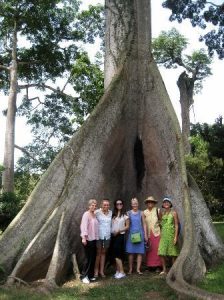
A historic pose at the Aburi Botanical Gardens
Mole National Park
The Mole National Park has been described as the largest national park in the country in the Northern Region. It has very rich flora and fauna. Over 93 species of mammals, about 300 species of birds, nine amphibians, 33 reptilian and several insectivorous species, and 56 endemic butterfly species have been recorded according to the park’s website.
It covers an area of 4,840 km2of undulating terrain with steep scarps. The vegetation is pristine Guinea savanna with gallery forests along the rivers and streams. Its mammal species include elephants, buffalo, roan, kob, hartebeest, waterbuck and more. There are also lions, hyenas and crocodiles.
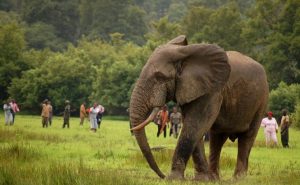
An elephant at the Mole National Park
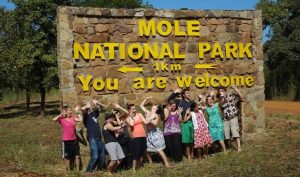
Some visitors at the Mole National Park
Paga Crocodile Pond
Don’t miss a trip to Paga crocodile pond. Located in the North-Eastern border of Ghana, Paga is a sacred crocodile sanctuary.
Although crocodiles are considered as wild creatures, the Paga crocodiles are friendly and co-exist with humans. The friendly relationship between the crocodiles and humans continue to baffle the minds of many. This is in contrast to the perception of crocodiles as dangerous.
It is a customary offence to harm, kill or show any sign of disrespect to the crocodile of Paga. It is not uncommon to find children and visitors sitting at the back of or holding the tale of a crocodile without any harm after a sacrifice of fowl.
This is normal for the people of Paga but a mystery to visitors. Other tourist attractions in the area include the Paga-Nania slave camp, the mystery dam of Kayoro called Kukula and the Nasaga Game Reserve, eight kilometres away from Burkina Faso and Paga.

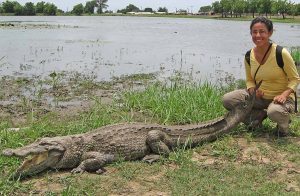

Time with some crocodiles at the Paga Crocodile Pond
Amedzofe
Amedzofe’s claim to fame is that at 750m altitude, it is Ghana’s highest settlement. The drive to the village, through the stunning Avatime Hills, is scenic and tortuous; it almost comes as a surprise when Amedzofe suddenly appears around a bend.
The village offers breathtaking vistas, a waterfall, forests, a cool climate and plenty of hiking opportunities. There’s a fantastic community-run visitor centre where you can arrange hikes. Popular choices include a 45-minute walk to Amedzofe Falls – the last section is treacherous – and a 30-minute walk to the summit of Mt Gemi (611m), one of the highest mountains in the area, where there is a 3.5m iron cross and stunning views.
Tafi Atome Monkey Santuary
Tafi Monkey Sanctuary (a sacred grove) is a traditional conservation area backed by statutory enforcement in co-operation with local communities. It is located in the Volta Region of Ghana. Tafi Atome is the home of Mona and Patas monkeys. These monkeys are found in a remnant patch of forests, which has survived fire and human disturbance around the village. These monkeys are regarded as gods and as such the natives do not kill them. They are protected by tradition.
Similar sacred groves and burial grounds protected by local people are widespread in the region. These can further be developed for small-scale tourism in the local communities to enhance rural development.
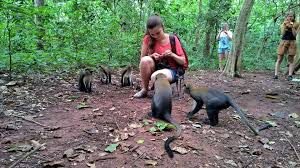
A visitor at Tafi Atome monkey sanctuary
Bui National Park
Bui National Park is the third largest Wildlife Protected Area in the country. It covers 1,821km² and is bisected by the Black Volta. It is located in a typical woodland savanna zone in the Brong-Ahafo and Northern Region of Ghana. It has spectacular gallery forests along rivers courses. The reserve is particularly notable for its resident hippo population in the Black Volta. Primates like the endangered black and white colobus monkey and a variety of antelopes and birds are also present.
Agumatsa Wildlife Sanctuary
Agumatsa wildlife sanctuary is located in the Hohoe District of the Volta Region on the Togo-Buen ranges. The area boasts of the most spectacular geographical feature in the district. An hour’s walk through cool shades of trees will lead you to Ghana’s highest waterfalls. The beauty of the falls is enhanced not only by the towering face of the gorge but most impressively by the several thousands of fruit bats clinging to its sides. This waterfall which consists of a series of four falls and two cascades descending an amazing 600m height is one of the perennial falls in Ghana open to visitors throughout the year. To get to the base of the falls from Wli-Agorviefe, one has to walk on a path which crosses the meandering Agumatasa River 11 times on locally-made log bridges. At the base of the falls, one will enjoy the beauty of nature in a cool microclimate. In addition to the forest are butterflies of various colours and other wild animals that make the area significant for conservation. The falls also plays an important part in the cultural life of the communities around it. The people regard it as a fetish protecting them in all walks of life. It is believed among the natives that it has power of curing barrenness in women.

